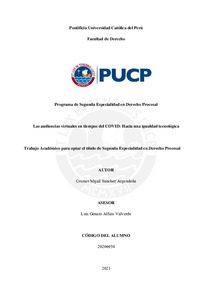| dc.contributor.advisor | Alfaro Valverde, Luis Genaro | |
| dc.contributor.author | Sanchez Argandoña, Cosmer Mijail | |
| dc.date.accessioned | 2021-09-25T01:34:21Z | |
| dc.date.available | 2021-09-25T01:34:21Z | |
| dc.date.created | 2021 | |
| dc.date.issued | 2021-09-24 | |
| dc.identifier.uri | http://hdl.handle.net/20.500.12404/20429 | |
| dc.description.abstract | La pandemia generada por el virus SARS-CoV2 y el aislamiento social, han generado un
mayor reto en la administración de justicia, permitiendo que hoy, se hable con más fuerza,
de una justicia digital caracterizada por el uso de las herramientas tecnológicas que
permitan que los procesos judiciales no se vean interrumpidos. Es por ello que el Consejo
Ejecutivo del Poder Judicial, ha emitido una serie de resoluciones administrativas que en
buena cuenta buscan la continuación de los procesos judiciales a través del uso de las
audiencias virtuales.
Sin embargo, la realidad nos muestra que existe una serie de brechas tecnológicas que se
presentan con mayor frecuencia en las zonas rurales y con mayor pobreza en nuestro país,
lo cual puede generar ciertos márgenes indefensión en las partes que participan en el
proceso judicial. Es por este motivo que el principal objeto de estudio será analizar la
regulación pertinente respecto a las audiencias judiciales virtuales y las principales
brechas tecnológicas que presentan los actores del proceso judicial durante el desarrollo
de las audiencias virtuales. | es_ES |
| dc.description.abstract | The pandemic generated by the SARS-CoV2 virus and social isolation have generated a
greater challenge in the administration of justice, allowing today, to speak with more
force, of a digital justice characterized by the use of technological tools that after judicial
processes are not interrupted. That is why the Executive Council of the Judiciary has
issued a series of administrative resolutions that in good account seek the continuation of
judicial processes through the use of virtual hearings.
However, reality shows us that there is a series of technological gaps that occur more
frequently in rural areas and with greater poverty in our country, which can generate a
kind of defenselessness of the parties that participate in the judicial process. For this
reason that the main object of study will analyze the relevant regulation regarding virtual
court hearings and the main technological gaps that the actors of the judicial process
present during the development of virtual hearings. | es_ES |
| dc.language.iso | spa | es_ES |
| dc.publisher | Pontificia Universidad Católica del Perú | es_ES |
| dc.rights | info:eu-repo/semantics/openAccess | es_ES |
| dc.rights.uri | http://creativecommons.org/licenses/by-sa/2.5/pe/ | * |
| dc.subject | Audiencias--Perú | es_ES |
| dc.subject | Administración de justicia--Perú | es_ES |
| dc.subject | Tecnología de la información--Perú | es_ES |
| dc.subject | COVID-19 (Enfermedad) | es_ES |
| dc.title | Las audiencias virtuales en tiempos del COVID: Hacia una igualdad tecnológica | es_ES |
| dc.type | info:eu-repo/semantics/bachelorThesis | es_ES |
| thesis.degree.name | Segunda Especialidad en Derecho Procesal | es_ES |
| thesis.degree.level | Título Profesional | es_ES |
| thesis.degree.grantor | Pontificia Universidad Católica del Perú. Facultad de Derecho | es_ES |
| thesis.degree.discipline | Derecho Procesal | es_ES |
| renati.advisor.dni | 40036838 | |
| renati.advisor.orcid | https://orcid.org/0000-0001-8433-4099 | es_ES |
| renati.author.dni | 71468174 | |
| renati.discipline | 421109 | es_ES |
| renati.level | https://purl.org/pe-repo/renati/level#tituloSegundaEspecialidad | es_ES |
| renati.type | https://purl.org/pe-repo/renati/type#trabajoAcademico | es_ES |
| dc.publisher.country | PE | es_ES |
| dc.subject.ocde | https://purl.org/pe-repo/ocde/ford#5.05.01 | es_ES |






